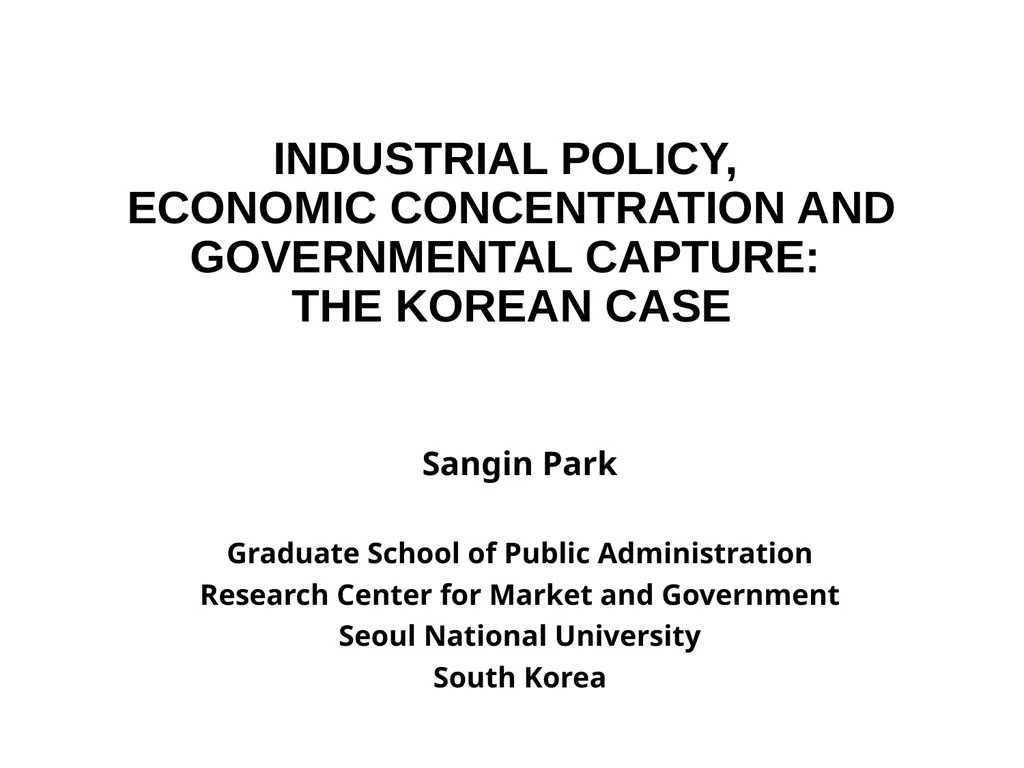Industrial policy, economic concentration and
Author : lindy-dunigan | Published Date : 2025-11-08
Description: Industrial policy economic concentration and governmental capture the Korean case Sangin Park Graduate School of Public Administration Research Center for Market and Government Seoul National University South Korea Making a Miracle
Presentation Embed Code
Download Presentation
Download
Presentation The PPT/PDF document
"Industrial policy, economic concentration and" is the property of its rightful owner.
Permission is granted to download and print the materials on this website for personal, non-commercial use only,
and to display it on your personal computer provided you do not modify the materials and that you retain all
copyright notices contained in the materials. By downloading content from our website, you accept the terms of
this agreement.
Transcript:Industrial policy, economic concentration and:
Industrial policy, economic concentration and governmental capture: the Korean case Sangin Park Graduate School of Public Administration Research Center for Market and Government Seoul National University South Korea “Making a Miracle” Robert E. Lucas, Jr., a Nobel laureate economist, called the economic growth of Korea a miracle in his Econometrica paper in 1993. 2 In the 1960s, the size and distribution of population, school enrollment ratio, export items, and living standard of Korea and Philippines were about the same. However, from 1960 to 1988, Philippine’s GDP per Capita increased at an annual rate of 1.8% while Korea’s GDP per Capita increased at an annual rate of 6.2%. As a result, Korea’s per capita income became three times larger than Philippine’s in 1988. Major Indicators of the Korean Economy, 1960 – 2000. 3 Why has Korea been successful? Korea’s Developmental strategy: Government-led, Chaebol-centered (chaebol is a large business group controlled by founder family in Korea) Effective in overcoming missing institutions of the financial market and the market for parts and components Efficient strategy for catch-up by imitation Merits-based reward system by providing a variety of business favors to high performing exporting firms The merits-based reward system, instead of relationship-based reward, is a unique characteristic of the Korean development. However, the economic development was accompanied with economic concentration by chaebols. 4 Top chaebols’ assets to GDP ratio, 2001-2017 Top chaebols’ sales to GDP ratio, 2001-2017 Top chaebols’ shares in market capitalization 2001-2016 The top four business groups are increasingly dominant The shares of top 4 business groups as a share of the top 30 groups in 2017 (2011 is shown in parentheses) Source: Yonhap News, 21 May 2017 8 4 groups : 52.7% (49.1%) 4 groups : 69.4% (62.3%) Changes and Challenges Changes from economic development: The problem of missing institutions has been resolved by the growth of financial market and market for parts and components. Innovation led growth becomes more important than imitation led growth. The concentration by Korean chaebols leads to economic blocs by chaebol in which vertical integration, internal trading and exclusive sub-contracting are prevalent. Challenges from economic concentration by chaebols Relationship-based allocation and tunneling in chaebol. Price squeezing and IP extortion in exclusive sub-contracting Governmental capture, judiciary capture, media capture 9 10 Intra-group trades and Tunneling in Korean chaebols 80% of chaebol group firms have intra-group trades between 2009 and 2017. These intra-group trades accounts for about 13%













